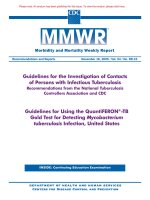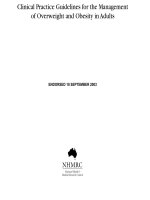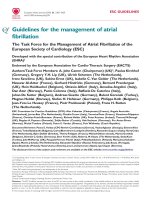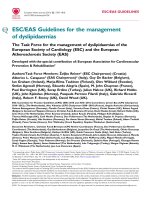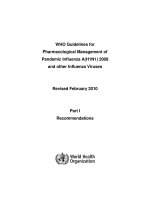WHO guidelines for the management of snake bite 2010
Bạn đang xem bản rút gọn của tài liệu. Xem và tải ngay bản đầy đủ của tài liệu tại đây (2.86 MB, 162 trang )
Guidelines for the
management of
snake-bites
David A Warrell
WHO Library Cataloguing-in-Publication data
Warrell, David A.
Guidelines for the management of snake-bites
1. Snake Bites – education - epidemiology – prevention and control – therapy.
2. Public Health.
3. Venoms – therapy.
6. South-East Asia.
4. Russell's Viper.
5. Guidelines.
7. WHO Regional Office for South-East Asia
ISBN 978-92-9022-377-4
(NLM classification: WD 410)
© World Health Organization 2010
All rights reserved. Requests for publications, or for permission to reproduce or translate WHO
publications, whether for sale or for noncommercial distribution, can be obtained from Publishing
and Sales, World Health Organization, Regional Office for South-East Asia, Indraprastha
Estate, Mahatma Gandhi Marg, New Delhi-110 002, India (fax: +91-11-23370197; e-mail:
publications@ searo.who.int).
The designations employed and the presentation of the material in this publication do not imply
the expression of any opinion whatsoever on the part of the World Health Organization concerning
the legal status of any country, territory, city or area or of its authorities, or concerning the
delimitation of its frontiers or boundaries. Dotted lines on maps represent approximate border
lines for which there may not yet be full agreement.
The mention of specific companies or of certain manufacturers’ products does not imply that they
are endorsed or recommended by the World Health Organization in preference to others of a
similar nature that are not mentioned. Errors and omissions excepted, the names of proprietary
products are distinguished by initial capital letters.
All reasonable precautions have been taken by the World Health Organization to verify the
information contained in this publication. However, the published material is being distributed
without warranty of any kind, either expressed or implied. The responsibility for the interpretation
and use of the material lies with the reader. In no event shall the World Health Organization be
liable for damages arising from its use.
This publication contains the collective views of an international group of experts and does not
necessarily represent the decisions or the stated policy of the World Health Organization.
Printed in India
GUIDELINES FOR THE MANAGEMENT OF SNAKE-BITES
Contents
Foreword...................................................................................................... v
Acknowledgements....................................................................................... vi
Preface to the second edition........................................................................ vii
1.
Executive summary. ...............................................................................1
2.
Prevention.............................................................................................5
3.
4.
5.
6.
7.
2.1
How can snake-bites be avoided...................................................... 5
2.2
Implementing preventive strategies for community education.............. 7
Venomous snakes of South-East Asia........................................................ 9
3.1
The venom apparatus..................................................................... 9
3.2
Classification of venomous snakes:
Medically important species in South-East Asia Region countries........ 11
3.3
How to identify venomous snakes.................................................. 32
Snake venoms. .................................................................................... 33
4.1
Venom composition...................................................................... 33
4.2
Quantity of venom injected at a bite, “dry bites”.............................. 34
Epidemiology of snake-bitein South-East Asia Region. ............................... 35
5.1
Introduction................................................................................ 35
5.2
Determinants of snake-bite incidence and severity of envenoming . ... 36
5.3
Epidemiological characteristics of snake-bite victims......................... 37
5.4
Circumstances of snake-bites........................................................ 37
5.5
Snake-bite as an occupational disease ........................................... 38
5.6
Death from snake-bite................................................................. 38
5.7
Snake-bite in different countries of SEA Region . ............................. 39
Symptoms and signs of snake-bite.......................................................... 47
6.1
When venom has not been injected................................................ 47
6.2
When venom has been injected..................................................... 47
Management of snake-bites in South-East Asia......................................... 61
7.1
Stages of management................................................................ 61
7.2
First-aid treatment....................................................................... 61
7.3
Transport to hospital.................................................................... 63
7.4
Treatment in the dispensary or hospital.......................................... 64
8.
Species diagnosis................................................................................. 71
9.
Investigations/laboratory tests............................................................... 73
9.1
20-minute whole blood clotting test............................................... 73
9.2
Other tests................................................................................. 73
10. Antivenom treatment............................................................................ 77
10.1 What is antivenom?..................................................................... 77
10.2 Indications for antivenom treatment ............................................. 78
10.3 Inappropriate use of antivenom..................................................... 78
iii
iv
GUIDELINES FOR THE MANAGEMENT OF SNAKE-BITES
10.4 How long after the bite can antivenom be expected to be effective?... 79
10.5 Antivenom reactions.................................................................... 79
10.6 Selection, storage and shelf life of antivenom ................................. 83
10.7 Administration of antivenom......................................................... 84
10.8 Dose of antivenom....................................................................... 86
10.9 Recurrence of systemic envenoming............................................... 88
10.10Criteria for repeating the initial dose of antivenom........................... 89
11. Conservative treatment when no antivenom is available. ........................... 91
12. Supportive/ancillary treatment............................................................... 93
13. Treatment of neurotoxic envenoming....................................................... 95
13.1 Introduction................................................................................ 95
13.2 Practical guide to airway management and respiratory support ......... 95
13.3 Trial of anticholinesterase........................................................... 106
14. Treatment of hypotension and shock..................................................... 109
15. Treatment of oliguria and acute kidney injury......................................... 111
15.1 Oliguric phase of renal failure...................................................... 111
15.2 Prevention of renal damage in patients with
myoglobinuria or haemoglobinuria............................................... 114
15.3 Diuretic phase of renal failure...................................................... 114
15.4 Renal recovery phase................................................................. 115
15.5 Persisting renal dysfunction......................................................... 115
16. Haemostatic disturbances.................................................................... 117
16.1 Dangers of venipuncture in patients with
haemostatic abnormalities.......................................................... 117
17. Treatment of the bitten part................................................................. 119
17.1 Bacterial infections.................................................................... 119
17.2 Compartmental syndromes and fasciotomy. ..............................119
17.3 Rehabilitation............................................................................ 121
18. Management of cobra spit ophthalmia .................................................. 123
19. Management of snake-bites at different levels of the health service........... 125
20. References and further reading............................................................. 129
Annexes
1.
Algorithm: Diagnosis of snake-bite cases based on clinical data................ 137
2.
Antivenoms for treatment of bites by South East Asian snakes.................. 140
3.
Pressure-immobilisation and pressure pad. ............................................ 145
4.
Measurement of central venous pressure............................................... 147
5.
Measurement of intracompartmental pressure in
tensely swollen snake-bitten limbs........................................................ 149
6.
Experts who contributed to the guidelines.............................................. 151
GUIDELINES FOR THE MANAGEMENT OF SNAKE-BITES
Foreword
Snake-bites are well-known medical emergencies in many
parts of the world, especially in rural areas. Agricultural
workers and children are the most affected. The incidence
of snake-bite mortality is particularly high in South-East
Asia.
Snake antivenom provides a specific lifesaving
measure. The current annual need for the treatment
of snake-bite envenoming amounts to 10 million vials
of antivenins. Unfortunately, the present worldwide production capacity is
well below these needs. This trend needs to be reversed through concerted
actions by national, regional and world health authorities and manufacturers
and through effective public – private partnership. The prevention of mortality
and morbidity depend upon availability of antivenom in the health facilities in
these settings and their rational use. Mechanisms need to be developed to
ensure access to antivenom by all needy patients. The health system needs
to respond to this challenge and logistics must be put in place to ensure
timely availability of antivenom at the point of use.
WHO/SEARO had developed guidelines on the management of snakebites which were also published as a special issue of the Southeast Asian
Journal of Tropical Medicine and Public Health in 1999. WHO has supported
countries in developing similar guidelines. To keep pace with the advances
in science and on the basis of global experience, the regional guidelines
have now been revised.
I hope that these guidelines will help Member States to improve their
management of snake-bites, especially in the peripheral health services and
shall be useful in saving human lives and mitigate misery due to snakebites.
Dr Samlee Plianbangchang
Regional Director
v
vi
GUIDELINES FOR THE MANAGEMENT OF SNAKE-BITES
Acknowledgements
Prof David Warrell, Emeritus Professor of Tropical Medicine, Oxford, UK wrote
the first draft of the Guidelines. These were finalized through a meeting of
experts held at Yangon, Myanmar in December 2009. The list of experts
who contributed can be seen as Annex 7. Contributions of all the experts
are sincerely acknowledged.
GUIDELINES FOR THE MANAGEMENT OF SNAKE-BITES
Preface to the second edition
Geographical coverage
The geographical area specifically covered by this publication extends from
India in the west to DPR Korea and Indonesia in the east, Nepal and Bhutan
in the north, and to Sri Lanka and Indonesia in the south and south-east.
Snakes inhabiting the Indonesian islands east of Wallace’s line (West Papua
and Maluku Islands) are part of the Australasian elapid fauna, differing from
those west of this line.
Snake-bite is a neglected tropical disease
Early in 2009, snake-bite was finally included in the WHO’s list of neglected
tropical diseases confirming
the experience in many parts of this region that snake-bite is a common
occupational hazard of farmers, plantation workers and others, resulting in
tens of thousands of deaths each year and many cases of chronic physical
handicap (WHO, 2007; Williams, 2010). Much is now known about the species
of venomous snakes responsible for these bites, the nature of their venoms
and the clinical effects of envenoming in human patients.
Antivenoms are essential drugs
The only specific antidotes to snake venoms are immunoglobulin antivenoms
which are now recognised as essential drugs (19.2 Sera and immunoglobulins)
/>en.pdf
Target readership
This publication aims to pass on a digest of available knowledge about all
clinical aspects of snake-bite to medically trained personnel. The guidelines
are intended for medical doctors, nurses, dispensers and community health
workers who have the responsibility of treating victims of snake-bite. They
aim to provide sufficient practical information to allow medically trained
personnel to assess and treat patients with snake-bites at different levels
of the health service.
vii
Levels of evidence
Recommendations are based largely on observational studies (“O” see below),
expert opinion (“E”) and, in some cases, comparative trials (“T”), but in only
one case on formal systematic reviews (“S”).
Symbols for the evidence used as the basis of each recommendation (in
order of level of evidence) are:
S formal systematic reviews, such as Cochrane Reviews of which there is only
one in the field of snake-bite. These include more than one randomized
controlled trial;
T comparative trials without formal systematic review;
O observational studies (e.g. surveillance or pharmacological data);
E expert opinion/consensus.
References and further reading
The restrictions on the size of this document prevented the inclusion of detailed
references to all the original publications on which these recommendations
were based. These can be found in the papers and reviews listed in “Further
Reading”.
Useful points raised by users of the first edition were the need to include
the snake species in Indonesia east of Wallace’s line (see above) and the
importance of providing guidance on initial dosages of the antivenoms now
listed in Annex 3 and Table 1.
WHO initiatives
This edition is updated to include the results of much additional clinical
research published since 1999 including two WHO publications, “Rabies and
envenomings : a neglected public health issue”, report of a Consultative
Meeting, WHO, Geneva, 10 January 2007 and “WHO Guidelines for the
Production, Control and Regulation of Snake Antivenom Immunoglobulins”
WHO Geneva 2010. These publications together with a venomous snakes and
antivenoms website are available online at />snake_antivenoms/en/
Any recommendations must be continually reconsidered in the light of
new evidence and experience. Comments from readers are welcomed
so that future editions can be updated and improved.
1
Executive summary
i.
It is clear that in many parts of the South East Asian region, snake-bite
is an important medical emergency and cause of hospital admission. It
results in the death or chronic disability of many active younger people,
especially those involved in farming and plantation work. However, the
true scale of mortality and acute and chronic morbidity from snake-bite
remains uncertain because of inadequate reporting in almost every part
of the region. To remedy this deficiency, it is strongly recommended that
snake-bite should be made a specific notifiable disease in all countries
in the South East Asian region.
ii.
Snake-bite is an occupational disease of farmers, plantation workers,
herdsmen, fishermen, snake restaurant workers and other food producers.
It is therefore a medical problem that has important implications for
the nutrition and economy of the countries where it occurs commonly.
It is recommended that snake-bite should be formally recognised as
an important occupational disease in the South East Asian region.
iii.
Despite its importance, there have been fewer proper clinical studies
of snake-bite than of almost any other tropical disease. Snakebites probably cause more deaths in the region than do Entamoeba
histolytica infections but only a small fraction of the research investment
in amoebiasis has been devoted to the study of snake-bite. It is
recommended that governments, academic institutions, pharmaceutical,
agricultural and other industries and other funding bodies, should
actively encourage and sponsor properly designed clinical studies of
all aspects of snake-bite.
iv.
Some ministries of health in the region have begun to organise training
of doctors and other medical workers in the clinical management of
snake-bite patients. However, medical personnel throughout the region
would benefit from more formal instruction on all aspects of the subject.
This should include the identification of medically-important species of
GUIDELINES FOR THE MANAGEMENT OF SNAKE-BITES
2
GUIDELINES FOR THE MANAGEMENT OF SNAKE-BITES
snakes, clinical diagnosis and the appropriate use of antivenoms and
ancillary treatments. It is recommended that education and training
on snake-bite should be included in the curriculum of medical schools
and should be addressed specifically through the organisation of special
training courses and other educational events.
v.
Community education on snake-bite is outside the terms of reference
of this publication.
However, it is clear that this is an essential component of any community
public health programme. Community education about venomous snakes
and snake-bite is strongly recommended as the method most likely to
succeed in preventing bites.
vi.
Most of the familiar methods for first-aid treatment of snake-bite, both
western and “traditional/herbal”, have been found to result in more
harm (risk) than good (benefit). Their use should be discouraged and
they should never be allowed to delay the movement of the patient
to medical care at the hospital or dispensary. Recommended first-aid
methods emphasise reassurance, immobilisation of the whole patient
and particularly the bitten limb and movement of the patient to a place
where they can receive medical care as soon as possible.
vii. Diagnosis of the species of snake responsible for the bite is important for
optimal clinical management. This may be achieved by identifying the
dead snake or by inference from the “clinical syndrome” of envenoming.
A syndromic approach should be developed for diagnosing the species
responsible for snake-bites in different parts of the region.
viii. Antivenom is the only effective antidote for snake venom. It is an
essential element of treatment of systemic envenoming but may be
insufficient on its own to save the patient’s life. Antivenom may be
expensive and in short supply.
a. It is recommended that antivenom should be used only in patients
in whom the benefits of treatment are considered to exceed the
risks of antivenom reactions. Indications for antivenom include signs
of systemic and/or severe local envenoming.
b. Skin/conjunctival hypersensitivity testing does not reliably predict
early or late antivenom reactions and is not recommended.
c. It is recommended that whenever possible antivenom should be
given by slow intravenous injection or infusion.
d. Epinephrine (adrenaline) should always be drawn up in readiness
in case of an early anaphylactic antivenom reaction.
GUIDELINES FOR THE MANAGEMENT OF SNAKE-BITES
e. No method of preventing antivenom reactions has been proved
effective, including prophylactic epinephrine/adrenaline.
ix.
When no antivenom is available, judicious conservative treatment can
in many cases save the life of the patient.
x.
In the case of neurotoxic envenoming with bulbar and respiratory
paralysis, antivenom alone cannot be relied upon to prevent early death
from asphyxiation. Artificial ventilation is essential in such cases.
xi.
Conservative management and, in some cases, dialysis, is an effective
supportive treatment for acute kidney injury in victims of Russell’s
viper, hump-nosed viper and sea snake-bites.
xii.
Fasciotomy should not be carried out in snake-bite patients unless
or until haemostatic abnormalities have been corrected, clinical
features of an intracompartmental syndrome are present and a
high intracompartmental pressure has been confirmed by direct
measurement.
3
2
Prevention
2.1 How can snake-bites be avoided
Snake-bite is an environmental, occupational and climatic hazard in rural and
urban areas of many countries of the South-East Asia Region of the WHO.
Attention to the following recommendations for community education might
reduce the risk of bites. Snakes have adapted to a wide range of habitats
and prey species. All snakes are predatory carnivores, none is vegetarian
although some eat eggs. Since snakes are preyed upon by other animals,
they tend to be secretive and have evolved many survival strategies. By
understanding something about the habits of snakes, simple precautions can
be adopted to reduce the chance of encounters and consequently bites. One
must know the local snakes, the sort of places where they prefer to live and
hide, the time of year and time of day or night and the kind of weather when
they are most likely to be actively out and about. Many species are mainly
nocturnal (night hunters) e.g. kraits, but other species are mainly diurnal
(day-time hunters). Be specially vigilant about snake-bites after rains, during
flooding, at harvest time and at night. Snakes prefer not to confront large
animals such as humans so give them the chance to slither away.
In the house: Snakes may enter the house in search of food or to
find a hiding place for a while. Do not keep livestock, especially chickens,
in the house, as snakes may come to hunt them. Store food in rat-proof
containers. Regularly check houses for snakes and, if possible, avoid those
types of house construction that will provide snakes with hiding places (e.g.
thatched rooves with open eaves, mud and straw walls with large cracks and
cavities and large unsealed spaces beneath floorboards). If possible, try to
avoid sleeping on the ground. If you have to sleep on the ground use an
insecticide-impregnated mosquito net that is well tucked in under the mattress
or sleeping mat [Evidence level T]. This will protect against mosquitoes
and other biting insects, centipedes, scorpions and snakes (Chappuis et al.,
2007). No chemical has yet been discovered that is effectively repellent to
snakes without being so toxic as to threaten the life of children and domestic
animals.
GUIDELINES FOR THE MANAGEMENT OF SNAKE-BITES
6
GUIDELINES FOR THE MANAGEMENT OF SNAKE-BITES
In the farm yard, compound or garden: Try not to provide hiding
places for snakes. Clear termite mounds, heaps of rubbish, building materials
etc. from near the house. Do not have tree branches touching the house.
Keep grass short or clear the ground around your house and clear low bushes
in the vicinity so that snakes cannot hide close to the house. Keep your
granary away from the house, it may attract rodents that snakes will hunt.
Water sources, reservoirs and ponds may also attract prey animals such as
frogs and toads. Listen to wild and domestic animals, especially birds, as
they warn of a snake nearby. Use a light when you walk outside the house
or visit the latrine at night.
In the countryside: Firewood collection at night is a real danger. Watch
where you walk. Rather than walking bare-footed or wearing sandals, use
proper shoes or boots and long trousers, especially when walking in the
dark or in undergrowth. Step on to rocks or logs rather than straight over
them – snakes may be sunning themselves on the sides. Do not put hands
into holes or nests or any hidden places where snakes might rest. Use a
light (torch, flashlight or lamp) when walking at night, especially after heavy
rains. Be careful when handling dead or apparently dead snakes – even
an accidental scratch from the fang of a snake’s severed head may inject
venom. Snake restaurants pose a threat of bites to staff and customers.
Many snake-bites occur during ploughing, planting and harvesting and in the
rainy season. Rain may wash snakes and debris into gutters at the edges of
roads, and flush burrowing species out of their burrows. Hence, be careful
when walking on roads after heavy rain, especially after dark.
On the road: Drivers or cyclists should never intentionally run over
snakes on the road. The snake may not be instantly killed and may lie
injured and pose a risk to pedestrians. The snake may also be injured and
trapped under the vehicle, from where it will crawl out once the vehicle has
stopped or has been parked in the house compound or garage.
In rivers, estuaries and the sea: To prevent sea snake-bites, fishermen
should avoid touching sea snakes caught in nets and on lines. The head
and tail are not easily distinguishable. There is a risk of bites to bathers
and those washing clothes in the muddy water of estuaries, river mouths
and some coastlines.
General: Avoid snakes as far as possible, including those displayed
by snake charmers who are frequently bitten. Never handle, threaten or
attack a snake and never intentionally trap or corner a snake in an enclosed
space. Keep young children away from areas known to be snake-infested.
In occupations that carry a risk of snake-bite, such as rice farming and
fish farming, employers might be held responsible for providing protective
clothing (boots). In Myanmar, farmers can take out special low-cost insurance
to cover them specifically against snake-bite.
GUIDELINES FOR THE MANAGEMENT OF SNAKE-BITES
2.2 Implementing preventive strategies for community
education
The above recommendations for preventing snake-bite can be disseminated
for national or local use as guidelines, training modules, leaflets, video
clips and posters that can be displayed on the walls of hospital and clinic
waiting areas for the attention of patients and their families. At the village
level, drama and puppet shows have been used successfully to portray
snake-bite scenarios. Media such as radio and TV can be used for health
promotion and advantage can be taken of FM radio phone-ins to publicise the
problem. Increasingly, young people and advertisers use mobile phones and
social networking (YouTube, Twitter) to communicate information. Religious
organizations and charities such as Rotary Club and Lions Club might be
persuaded to promote snake-bite awareness. It is especially valuable to
win the support of high profile media figures such as film stars, pop stars,
sporting heroes and politicians.
7
3
Venomous snakes of South-East Asia
3.1 The venom apparatus
The ability to inject venom into prey animals by means of cannulated,
modified teeth evolved over 140 million years ago in bird-like dinosaurs
and later in snakes (Gong et al., 2010). The venom glands of Elapidae and
Viperidae are situated behind the eye, surrounded by compressor muscles
(Gans and Gans 1978; Junghanss and Bodio 1995) (Fig. 1).
Figure 1: Venom apparatus of an eastern Russell’s viper
(Daboia siamensis) (Copyright DA Warrell)
The venom duct opens within the sheath at the base of the fang and
venom is conducted to its tip through a groove or canal, as through a
hypodermic needle. In Elapidae, the (proteroglyph) fangs are mounted on
a relatively fixed maxilla at the front of the mouth (Fig. 2a). In Viperidae,
the (solenoglyph) fangs are mounted on a rotatable maxilla so that they
can be folded flat against the roof of the mouth (Fig. 2b). In Colubridae
(used here in the broad sense, including some newly separated families),
venom secreted by Duvernoy’s (supralabial) glands tracks down grooves
GUIDELINES FOR THE MANAGEMENT OF SNAKE-BITES
10
GUIDELINES FOR THE MANAGEMENT OF SNAKE-BITES
in the anterior surfaces of (opisthoglyph) fangs at the posterior end of the
maxilla (Fig. 2c). Fangs allow the snake to introduce venom deep into the
tissues of its natural prey. If a human is bitten, venom is usually injected
subcutaneously or intramuscularly. Spitting cobras can squeeze the venom
out of the tips of their fangs producing a fine spray directed towards the
eyes of an aggressor. The average dry weight of venom injected at a strike
is approximately 60 mg in N. naja, 13 mg in E. carinatus and 63 mg in
D. russelii.
Figure 2a: Short, permanently erect, front fangs of a typical elapid
(Sri Lankan cobra - Naja naja) (Copyright DA Warrell)
Figure 2b: Long, hinged, front fangs of a typical viper
(Thailand Russell’s viper Daboia siamensis). A reserve fang is seen
immediately behind the active fang. (Copyright DA Warrell)
GUIDELINES FOR THE MANAGEMENT OF SNAKE-BITES
Figure 2c: Rear fangs of a dangerously venomous Colubrid snake, the
red-necked keelback (Rhabdophis subminiatus) (Copyright DA Warrell)
3.2 Classification of venomous snakes: Medically
important species in South-East Asia Region
countries (WHO 2010)
There are three families of venomous snakes in South-East Asia, Elapidae,
Viperidae and Colubridae.
Elapidae: have relatively short fixed front (proteroglyph) fangs
(Fig. 2a). This family includes cobras, king cobra, kraits, coral snakes,
Australasian snakes and sea snakes. Elapidae are relatively long, thin,
uniformly-coloured snakes with large smooth symmetrical scales (plates)
on the top (dorsum) of the head. There is no loreal scale between the preocular and nasal scales. Some, notably cobras, raise the front part of their
body off the ground and spread and flatten the neck to form a hood (Fig.
3-8). Several species of cobra can spit their venom for one metre or more
towards the eyes of perceived enemies. Venomous sea snakes have flattened
paddle-like tails and their ventral scales are greatly reduced in size or lost
(Fig. 20-24).
11
12
GUIDELINES FOR THE MANAGEMENT OF SNAKE-BITES
Some of the Elapidae inhabiting SEARO countries (References to
reports of bites by these species are given in parenthesis):
Cobras (genus Naja):
Figure 3: Common spectacled cobra (Naja naja): (a) and (b) Sri Lanka,
(c) India (Copyright DA Warrell), (d) Nepal (Copyright Mark O’Shea)
a
d
b
c
Common spectacled Indian cobra N. naja (Fig. 3) (Theakston et al., 1990)
Figure 4: North Indian or Oxus cobra (Naja oxiana)
(Copyright DA Warrell)
North Indian or Oxus cobra N. oxiana (Fig. 4) (Warrell, 1995).
GUIDELINES FOR THE MANAGEMENT OF SNAKE-BITES
Figure 5: Monocellate cobras (Naja kaouthia) (Copyright DA Warrell) (a)
specimen from India (b) specimen from Thailand (c) specimen from
Thailand showing single “eye” marking on back of hood
(Copyright DA Warrell)
a
b
c
Monocellate cobra N. kaouthia (Fig. 5a-c) (Reid 1964; Warrell 1986; Viravan
et al., 1992)
Figure 5d: Andaman cobra Naja sagittifera juvenile specimen
(Copyright Ashok Captain)
Andaman cobra Naja sagittifera (Fig. 5d)
13
14
GUIDELINES FOR THE MANAGEMENT OF SNAKE-BITES
Figure 6: Indo-Chinese spitting cobra (Naja siamensis) specimens from
Thailand (Copyright DA Warrell)
(a) Brown-coloured specimen (b) Black and white specimen with illdefined spectacle marking on hood
a
b
Spitting cobras: N. siamensis (Fig. 6) (Warrell 1986; Wüster et al., 1997),
N. sumatrana (Fig. 7), N. sputatrix, N. mandalayensis etc
Figure 7: Sumatran spitting cobra (Naja sumatrana)
(Copyright DA Warrell)
(a) black phase (b) golden phase
a
b
GUIDELINES FOR THE MANAGEMENT OF SNAKE-BITES
Figure 8: King cobra or hamadryad (Ophiophagus hannah)
(Copyright DA Warrell)
(a) The famous king cobra dance in Yangon, Myanmar
(b) Specimen from Thailand more than 3.5 metres in total length
(c) (d) (e) Dorsal and lateral views of head of Thai (c,d) and Indian
(e) specimens showing the two large occipital scales (arrows) which
distinguish this species from cobras (Naja)
a
b
c
d
e
King cobra: Ophiophagus hannah (Fig.. 8) (Tin-Myint et al., 1991)
15
16
GUIDELINES FOR THE MANAGEMENT OF SNAKE-BITES
Kraits (genus Bungarus):
Figure 9: Common krait (Bungarus caeruleus) (Copyright DA Warrell)
(a) Sri Lankan specimen showing narrow white dorsal bands
(b) Indian specimen showing pure white ventrals
a
b
Common krait B. caeruleus (Fig. 9) (Theakston et al., 1990; Ariaratnam et
al., 2009)
Figure 10: Malayan krait (Bungarus candidus) Thai specimen
(Copyright DA Warrell)
(a) Showing dorsal black saddle-shaped markings
(b) Showing pure white ventrals
a
b
Malayan krait B. candidus (Fig. 10) (Warrell et al., 1983; Kiem-Xuan-Trinh
et al., 2010)
Figure 11: Chinese krait (Bungarus multicinctus) (Copyright DA Warrell)
Chinese krait B. multicinctus (Fig. 11) (Tun-Pe et al., 1997; Ha-Tran-Hung
et al., 2009; Ha-Tran-Hung et al., 2010)





